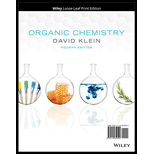
(a)
Interpretation: The reagent used in the given reaction is to be identified.
Concept introduction: Sodium dichromate
(b)
Interpretation: The reagent used in the given reaction is to be identified.
Concept introduction:
(c)
Interpretation: The reagent used in the given reaction is to be identified.
Concept introduction:
(d)
Interpretation: The reagent used in the given reaction is to be identified.
Concept introduction: Sodium dichromate
(e)
Interpretation: The reagent used in the given reaction is to be identified.
Concept introduction: With the aid of reagents like sodium borohydride or lithium aluminum hydride, aldehydes and ketones can undergo a reduction process to produce either primary alcohol or secondary alcohol.
(f)
Interpretation: The reagent used in the given reaction is to be identified.
Concept introduction:
With the aid of reagents like sodium borohydride or lithium aluminum hydride, aldehydes and ketones can undergo a reduction process to produce either primary alcohol or secondary alcohol.
Want to see the full answer?
Check out a sample textbook solution
Chapter 12 Solutions
ORGANIC CHEMISTRY-PRINT COMPANION (LL)
- Using your reaction roadmap as a guide, show how to convert cyclohexanol into racemic trans-1,2-cydohexanediol. Show all required reagents and all molecules synthesized along the way.arrow_forwardWhen cis-2-decalone is dissolved in ether containing a trace of HCI, an equilibrium is established with trans-2-decalone. The latter ketone predominates in the equilibrium mixture. H H HCI cis-2-Decalone trans-2-Decalone Propose a mechanism for this isomerization and account for the fact that the trans iso- mer predominates at equilibrium.arrow_forwardHow would you carry out the following transformations. Indicate the appropriete reagents in each case.arrow_forward
- Using your reaction roadmap as a guide, show how to convert butane into butanal. Show all reagents needed and all molecules synthesized along the way.arrow_forwardWhich of the following sequences of reactions would convert toluene to 2-bromo-4-cyanotoluene? ? Br CN Nitration, bromination, reduction, diazotization, reaction with cyanide anion Bromination, nitration, reduction, diazotization, reaction with cyanide anion Bromination, nitration, diazotization, reduction , reaction with cyanide anion Nitration, bromination, diazotization, reduction, reaction with cyanide anionarrow_forwardPredict the products formed when cyclohexanone reacts with the following reagents. h) sodium acetylide, then mild H3O+arrow_forward
- Select the correct set of reagents to carry out the following transformations: G HO HO to OH CI A MgCIarrow_forwardProvide reagents needed for the following transformations. More than one step is required for each reaction. 1 2 3 t 'Br Provide missing reagents Provide missing reagents Provide missing reagents In OH u OHarrow_forwardShow how you would convert 2-methylcyclopentanol to the following products. Any of these products may be used as thereactant in any subsequent part of this problem. 2-methylcyclopentyl tosylatearrow_forward
- Identify reagents that can be used to achieve each of the following transformationsarrow_forwardPropose a possible reaction mechanism for the following transformation. Draw out the steps with the correct reaction arrows.arrow_forwardCyclohexene can be converted to 1-cyclopentenecarbaldehyde by the following series of reactions. Propose a structural formula for each intermediate compound.arrow_forward

 Organic ChemistryChemistryISBN:9781305580350Author:William H. Brown, Brent L. Iverson, Eric Anslyn, Christopher S. FootePublisher:Cengage Learning
Organic ChemistryChemistryISBN:9781305580350Author:William H. Brown, Brent L. Iverson, Eric Anslyn, Christopher S. FootePublisher:Cengage Learning

